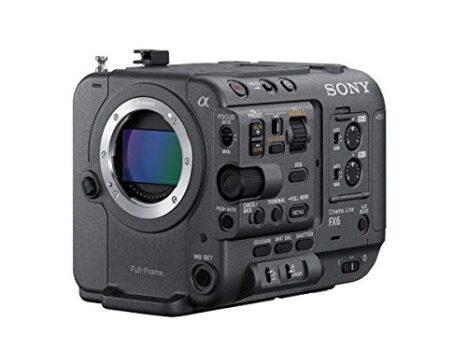Ultimate Mobility and Cinematic Expression: A Technical Deep Dive into the SONY ILME-FX6 Cinema Line Full-Frame Camera
Introduction: Redefining Cinematic Freedom
In the ever-evolving landscape of digital cinematography, the demand for compact, powerful, and versatile tools has never been higher. Filmmakers, from independent creators to large production houses, constantly seek a camera that can deliver breathtaking cinematic quality without the constraints of traditional, cumbersome rigs. Sony, a titan in the imaging world, answered this call with its acclaimed Cinema Line, and arguably one of its most pivotal creations is the SONY ILME-FX6 Cinema Line Full-Frame Camera. Positioned strategically between the ultra-compact FX3 and the high-end FX9, the FX6 emerges as a masterstroke of engineering, blending a full-frame sensor’s aesthetic prowess with a feature set designed for the modern, run-and-gun documentarian, event videographer, and narrative filmmaker. This is not merely another camera; it is a statement of intent from Sony, a tool engineered to democratize high-end cinematic production.
This review is a comprehensive technical analysis of the SONY ILME-FX6. We will move beyond surface-level specifications to dissect the core technologies that make this camera a formidable force in the industry. From its back-illuminated Exmor R sensor and its groundbreaking Fast Hybrid Autofocus system to the revolutionary electronic variable ND filter, we will explore how each component contributes to the final image and the overall shooting experience. We will benchmark its performance in various shooting scenarios, evaluate its ergonomic design for practical usability, and assess its place within a professional workflow. For the discerning professional looking to invest in a new workhorse or the aspiring filmmaker ready to elevate their craft, this deep dive will provide the critical insights needed to understand the true power and potential of the SONY ILME-FX6.

Deconstructing the Core: A Technical Feature Analysis
The true measure of a professional cinema camera lies in the synergy of its core technologies. The SONY ILME-FX6 is a testament to this principle, with each feature meticulously engineered to serve a distinct purpose in the cinematic workflow. Let’s dissect the foundational pillars of its design.
1. The Heart of the Image: 10.2MP 4K Full-Frame Back-Illuminated Exmor R CMOS Sensor
At the core of the FX6’s imaging capabilities is its 10.2-megapixel full-frame Exmor R CMOS sensor. The choice of a relatively low megapixel count is a deliberate and brilliant engineering decision tailored specifically for high-quality video production. Unlike hybrid cameras that must compromise for high-resolution stills, the FX6’s sensor is optimized for 4K video. This lower pixel density translates to significantly larger individual photosites (pixels). Larger pixels capture more light, which is the fundamental reason for the FX6’s legendary low-light performance and high signal-to-noise ratio. This results in cleaner images with finer detail and richer color tonality, even when pushing the ISO to extreme levels.
The “Exmor R” designation signifies Sony’s back-illuminated sensor technology. In a traditional front-illuminated sensor, the metal wiring layer sits on top of the photodiode, partially obstructing the path of incoming light. Back-illumination reverses this structure, placing the wiring behind the photodiode. This architectural shift dramatically increases the light-gathering efficiency of each pixel, further enhancing sensitivity and reducing noise, a critical advantage in documentary or event settings where lighting conditions are often uncontrollable. Furthermore, the sensor facilitates a full-pixel readout without pixel binning for its 4K capture. It effectively reads out a 4.2K image and downsamples it to DCI 4K (4096 x 2160) or UHD 4K (3840 x 2160), resulting in an image with exceptional sharpness, clarity, and a significant reduction in moiré and aliasing artifacts. The readout speed of this sensor is also incredibly fast, which directly contributes to minimizing the rolling shutter effect—the “jello” artifact seen during fast pans or with rapid subject movement.
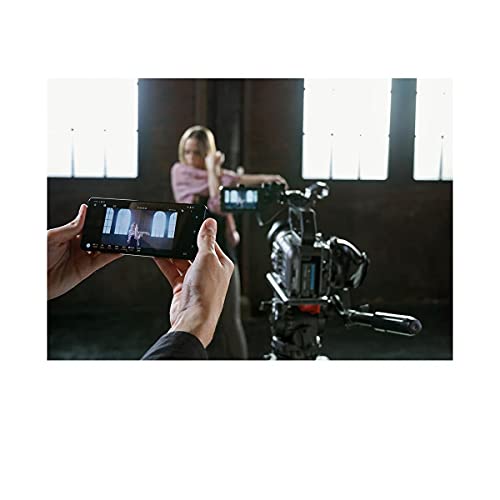
2. Mastering Light and Shadow: Dual Base ISO and 15+ Stops of Dynamic Range
The SONY ILME-FX6 boasts a staggering 15+ stops of dynamic range when shooting in S-Log3, a capability that places it firmly in the territory of high-end cinema cameras. Dynamic range refers to the camera’s ability to capture detail in the brightest highlights and darkest shadows of a scene simultaneously. A wide dynamic range provides immense flexibility in post-production, allowing colorists to push and pull the image, recover seemingly lost detail, and craft nuanced, cinematic looks without the footage falling apart into a noisy or banded mess. This latitude is the difference between a flat, video-like image and a rich, filmic one.
A key technology enabling this performance is the camera’s Dual Base ISO system. The FX6 features a base ISO of 800 and a high base ISO of 12,800. These are the two sensitivity levels at which the sensor produces the cleanest image with the widest dynamic range. When shooting in well-lit environments, the ISO 800 base provides a pristine, noise-free image. However, when light becomes scarce, instead of simply amplifying a noisy signal from the 800 base, the user can switch to the high base of 12,800. At this point, the sensor physically alters its circuitry to operate at a higher native sensitivity, producing an image that is remarkably clean for such a high ISO value. This makes the FX6 a low-light powerhouse, enabling filmmakers to capture usable, cinematic footage in environments that would be impossible for many other cameras, using minimal to no additional lighting.
3. The Autofocus Revolution: Fast Hybrid AF with Real-time Eye AF
Sony’s autofocus technology is arguably the best in the industry, and the system implemented in the FX6 is a marvel of technical innovation. The Fast Hybrid AF system combines the strengths of two different AF technologies. It utilizes 627 focal-plane phase-detection AF points, which are incredibly fast and accurate for tracking moving subjects, covering approximately 89% of the sensor area. This is complemented by contrast-detection AF, which excels at fine-tuning focus for maximum sharpness. The synergy between these two systems, powered by a sophisticated algorithm, delivers autofocus that is not only fast but also uncannily smooth, decisive, and reliable.
The true game-changer, however, is the implementation of Real-time Eye AF and subject tracking. Leveraging advanced AI and machine learning, the camera can identify a human eye with incredible precision and lock onto it, maintaining focus even as the subject moves, turns, or is partially obscured. This technology has been extended to track faces and even specific objects designated by the user on the touchscreen. For single operators, gimbal users, or documentary filmmakers, this is a revolutionary feature. It frees the filmmaker from the constant worry of pulling focus manually, allowing them to concentrate on composition, movement, and storytelling, confident that the critical element of the shot will remain perfectly sharp. The AF transition speed and subject shift sensitivity are also highly customizable, allowing the user to tailor the autofocus behavior to their specific creative needs, from slow, cinematic rack focuses to lightning-fast tracking for sports or action.
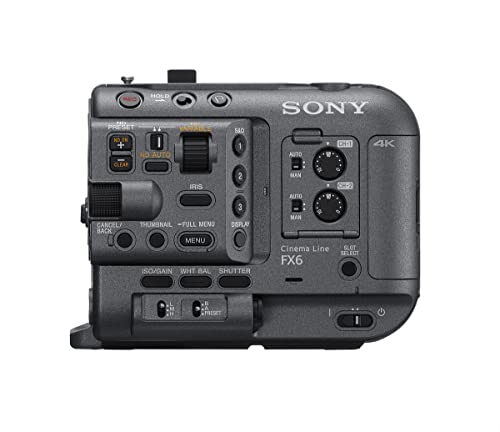
4. Unprecedented Creative Control: The Electronic Variable ND Filter
Perhaps the most unique and celebrated feature of the SONY ILME-FX6 is its electronically controlled optical variable Neutral Density (ND) filter. Traditional cinema cameras often use a mechanical wheel with fixed ND filters of varying strengths (e.g., ND .6, ND 1.2). While effective, this system is stepped and can be disruptive to the shot. Sony’s electronic system is a completely different paradigm. It is a single, solid-state liquid crystal device that can smoothly and seamlessly vary its density from 1/4 (2 stops) to 1/128 (7 stops). This provides an unprecedented level of exposure control.
The practical implications of this technology are immense. A filmmaker can maintain a constant aperture (and thus a consistent depth of field) while moving from a dark interior to a bright exterior, with the camera smoothly compensating for the exposure change. This is impossible with traditional ND filters. The filter can be controlled in several ways: manually via a dedicated wheel on the camera body in fine, stepless increments; in preset steps like a traditional ND wheel; or, most impressively, in a fully automatic mode. When set to Auto ND, the camera will use the filter to maintain a target exposure, leaving ISO and aperture fixed. This allows the operator to set their desired creative look (e.g., f/2.8 at ISO 800) and let the camera handle all exposure changes via the ND filter alone. This is an incredible tool for run-and-gun shooting, ensuring perfect exposure in dynamic lighting situations without any visible shifting in iris or gain.
5. Workflow and Flexibility: Codecs, Frame Rates, and I/O
The FX6 is built for the rigors of professional production, offering a wide array of recording options to suit any workflow. It can record in both XAVC-I (All-Intra) and XAVC-L (Long GOP) codecs. XAVC-I provides the highest quality by compressing each frame individually, making it easier on computer processors during editing but resulting in larger file sizes. XAVC-L uses interframe compression for smaller file sizes, ideal for longer recording times. The ability to record in 10-bit color depth with 4:2:2 chroma subsampling is a critical professional specification. It means the camera captures over a billion shades of color and provides more color information for each pixel, which is essential for heavy color grading, green screen work, and avoiding banding in subtle gradients like skies.
The frame rate options are comprehensive. It can capture stunning overcranked slow motion at DCI 4K up to 60p and QFHD 4K at up to 120p. For even more dramatic slow motion, it offers Full HD recording at up to 240p. This versatility allows filmmakers to capture everything from standard cinematic 24p to breathtaking action and beauty shots. On the physical side, the camera is equipped with professional I/O, including a 12G-SDI output for high-quality monitoring and external recording, a full-size HDMI output, timecode in/out for multi-camera synchronization, and dual XLR inputs on the detachable smart handle for professional audio capture. It records to dual media slots that are compatible with both the incredibly fast CFexpress Type A cards (necessary for the highest frame rate recordings) and universally available SDXC V90 cards, providing flexibility and redundancy.
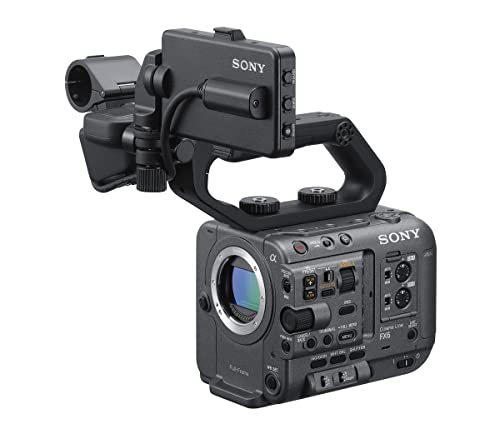
Performance in the Field: Ergonomics and Real-World Usability
Technical specifications on paper are one thing; how a camera performs in the heat of a real-world shoot is another. The SONY ILME-FX6 truly shines when you get it out of the box and onto your shoulder, gimbal, or tripod. Its design philosophy is centered around modularity and operator comfort.
Build and Handling
The camera body itself is remarkably compact and lightweight, weighing just under 2 lbs (0.89 kg). This makes it an ideal candidate for gimbal work, drone mounting, or long handheld shooting days where operator fatigue is a major concern. The body is constructed from a durable magnesium alloy chassis, ensuring it can withstand the bumps and scrapes of professional use. The modular design is a key strength. The camera can be stripped down to its core body for the smallest possible footprint or built up with its Smart Handle and Smart Grip for a more traditional ENG-style setup.
The Smart Handle, which attaches to the top of the camera via a NATO rail and two screws, is not just a carrying handle. It houses the camera’s two full-size XLR inputs, comprehensive audio controls, a multi-interface shoe, and multiple mounting points. The Smart Grip is ergonomically designed to fit comfortably in the hand and provides assignable buttons, a zoom rocker, and a joystick for menu navigation, putting essential controls right at the operator’s fingertips. This level of customization and adaptability means the FX6 can be configured for virtually any shooting style, from a solo documentarian to a small crew on a narrative set.
Image Quality: S-Cinetone and S-Log3
The image that comes out of the SONY ILME-FX6 is nothing short of spectacular. For productions with tight turnaround times, Sony’s S-Cinetone picture profile is a gift. Inherited from the high-end VENICE cinema camera, S-Cinetone is engineered to produce a beautiful, cinematic look straight out of the camera. It delivers pleasing, natural skin tones, a soft highlight roll-off, and rich mid-tones, providing a filmic look that requires minimal to no color grading. This is invaluable for corporate, event, and documentary work where speed is of the essence.
For projects that demand the utmost in post-production flexibility, shooting in S-Log3/S-Gamut3.Cine unlocks the sensor’s full 15+ stops of dynamic range. The 10-bit footage holds up exceptionally well to aggressive grading. Pushing shadows reveals clean detail with well-controlled noise, while highlights can be recovered without harsh clipping. The color science is robust, allowing colorists to craft highly stylized looks or achieve perfect color matching with other high-end cinema cameras in a multi-camera shoot. The combination of the full-frame sensor and these advanced color profiles allows filmmakers to achieve a shallow depth of field and beautiful bokeh that is synonymous with a high-end cinematic aesthetic.
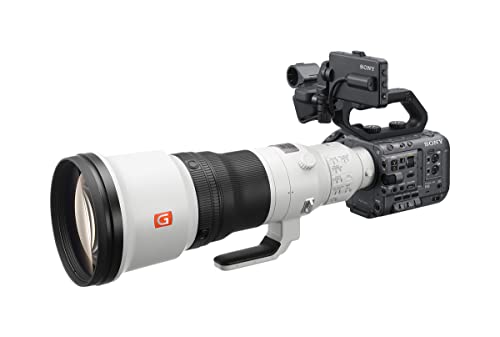
Pros: The Defining Strengths
- Unmatched Low-Light Capability: The combination of a full-frame sensor with large pixels and the Dual Base ISO system (800/12,800) makes the FX6 one of the best low-light cameras on the market, producing clean images in near darkness.
- Revolutionary Electronic Variable ND: The ability to smoothly and automatically adjust ND from 2 to 7 stops without changing aperture is a game-changing feature that provides unparalleled creative control over exposure and depth of field.
- Class-Leading Autofocus: The Fast Hybrid AF with Real-time Eye AF and subject tracking is incredibly reliable, fast, and intelligent, making it an indispensable tool for single operators, documentarians, and gimbal users.
- Compact and Modular Design: Its lightweight magnesium alloy body can be stripped down for gimbals or built up for shoulder-mounted work, offering incredible versatility for various production environments.
- Professional Codecs and Frame Rates: The inclusion of 10-bit 4:2:2 recording, XAVC-I, and high frame rates up to 4K 120p and FHD 240p ensures the camera meets the highest standards for professional post-production.
- Excellent I/O and Audio: With 12G-SDI, HDMI, Timecode, and dual XLR inputs, the FX6 integrates seamlessly into professional workflows without the need for extensive rigging.
Cons: Potential Considerations
- Limited Stills Capability: With a 10.2MP sensor, the FX6 is a dedicated video camera. It is not suitable for hybrid shooters who require high-resolution still photographs.
- Proprietary Media Cost: To unlock the camera’s highest frame rates, you need to use CFexpress Type A cards, which are currently more expensive and less common than the Type B variant or standard SD cards.
- Menu System Complexity: While improved, Sony’s menu system can still be daunting for newcomers. However, the extensive assignable buttons and a customizable “My Menu” page help to mitigate this once the camera is set up.
- External RAW Recording: Unlike some of its direct competitors, the FX6 requires an external recorder (like the Atomos Ninja V+) to capture ProRes RAW video via its SDI output.

Conclusion: The New Workhorse for the Modern Filmmaker
The SONY ILME-FX6 Cinema Line Full-Frame Camera is a triumph of thoughtful design and powerful technology. It successfully bridges the gap between mirrorless hybrids and high-end cinema cameras, offering the best of both worlds: the image quality, dynamic range, and professional features of a cinema camera packed into a body that offers the mobility and autofocus intelligence of a mirrorless system. The electronic variable ND filter and the Real-time Eye AF are not just convenient features; they are transformative technologies that fundamentally change how filmmakers can approach a scene, enabling shots that were previously difficult or impossible for a small crew to achieve.
This camera is not for everyone. Hybrid photographers or those needing internal RAW recording may look elsewhere. But for its target audience—documentary filmmakers, event videographers, high-end content creators, and independent narrative directors—the FX6 is arguably one of the most capable and versatile tools available today. It is a camera that empowers creativity, removes technical barriers, and consistently delivers a stunning cinematic image. It is a reliable workhorse that is just as comfortable on a tripod for a studio interview as it is on a gimbal capturing a dynamic action sequence. For any professional seeking a primary camera that offers unparalleled performance, flexibility, and value, the SONY ILME-FX6 represents a profound investment in their craft and a powerful tool for bringing their vision to life.
